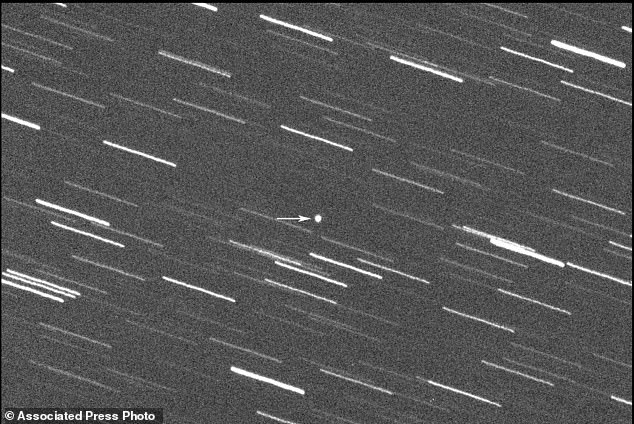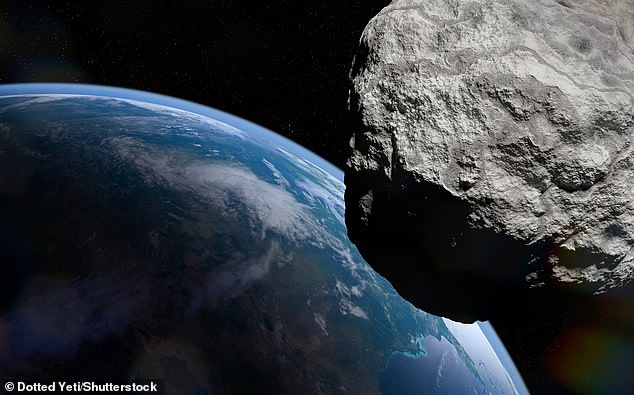A “potentially dangerous” asteroid the size of a football stadium will skim past Earth later today.
The asteroid, called 2008 OS7, is expected to approach within 1.7 million miles of our planet at 14:41 GMT, about seven times farther than the Moon.
It is estimated to be up to 480 meters (1,574 ft) in diameter, which is longer than Tottenham Hotspur’s stadium (820 feet or 250 meters).
When 2008 OS7 passes by Earth, it will travel at a speed of 18.1 km per second or just over 40,000 miles per hour, about 50 times the speed of sound.
The asteroid is “potentially dangerous”, although fortunately it is not expected to pose a danger to our planet.
When 2008 OS7 passes by Earth, it will travel at a speed of 18.1 km per second or just over 40,000 miles per hour, about 50 times the speed of sound (artist’s impression).

This 180-second exposure shot provided by the Virtual Telescope Project in Italy shows asteroid 2008 OS7 during its approach to Earth on January 31, 2024. Astronomers say a skyscraper-sized asteroid will pass at 1.7 million miles from Earth on Friday. There is no chance of it hitting us since it will travel seven times the distance between the Earth and the Moon.
Asteroid 2008 OS7, discovered in 2008 by the Catalina Sky Survey in Arizona, completes one orbit around the Sun every 962 days (2.63 years).
But in doing so, it intersects Earth’s orbit, according to Dr. Minjae Kim, a space expert at the University of Warwick’s astronomy department.
He describes it as “very small” in relative terms, because the largest known asteroid in the solar system, Ceres, is 580 miles in diameter (more than 3 million feet), big enough for humans to live on.
“2008 OS7, a very small asteroid whose orbit intersects that of Earth, has been classified as a ‘potentially hazardous asteroid,'” Dr. Kim said.
«Although it will continue to approach Earth, we should not worry too much because this asteroid will not enter the Earth’s atmosphere.
‘One of the most intriguing aspects of the 2008 OS7 is its estimated diameter based on its luminosity and reflective properties.
“This puts it in the category of small to moderate-sized asteroid, roughly equivalent to the size of a football field.”
According to NASA, the asteroid is between 210 and 480 meters (688 and 1,574 feet) in diameter.

The photo shows the asteroid’s orbital path in white, as well as the orbits of Earth (blue), Mars (red), Venus (purple) and Mercury (pink).

It is estimated to be up to 480 meters (1,574 feet) in diameter, which is longer than Tottenham Hotspur’s stadium (250 meters or 820 feet, pictured).
Unfortunately, this asteroid will be too small to be seen with the naked eye, or even with the average telescope.
NASA lists 2008 OS7 as one of the next approaches on its online tracker, which collects the next objects that are getting closer and closer to Earth.
An asteroid is defined as “potentially hazardous” if it is within 0.05 astronomical units (4.65 million miles) from Earth and is more than 459 feet (140 meters) in diameter.
Despite being seven times farther away than the Moon when it approaches, the asteroid is classified as a near-Earth object (NEO) and is being tracked by the space agency.
“OCTs are comets and asteroids that have been pushed by the gravitational attraction of nearby planets into orbits that allow them to penetrate the vicinity of Earth,” NASA stated.
“Composed primarily of water ice embedded with dust particles, comets originally formed in the cold outer planetary system, while most rocky asteroids formed in the warmer inner solar system, between the orbits of Mars and Jupiter. .
“Scientific interest in comets and asteroids is largely due to their status as relatively unaltered remnants of the formation process of the solar system about 4.6 billion years ago.”
On average, Earth is hit by a rock the size of a football field every 5,000 years and a civilization-ending asteroid every one million years, according to NASA’s Near-Earth Object Program.
Asteroid 2008 OS7 won’t appear again until 2032, but it will be a much more distant encounter, 72 million kilometers (45 million miles) away.


